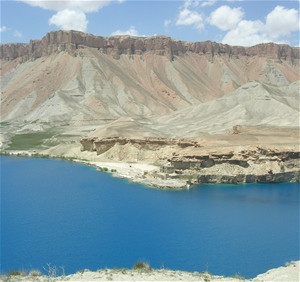
Breathtaking views such as this one await Afghan and international tourists who visit Band-e-Amir National Park in Bamyan province.
Wildlife Conservation Society
USAID worked with local communities to establish the first national park in Afghanistan.
4 MAY 2010 | BAND-E-AMIR, BAMYAN PROVINCE, AFGHANISTAN
The beauty of central Bamyan province’s six cobalt-blue Band-e-Amir lakes always stuns visitors. Natural travertine dams, created by calcium deposits over many years, support the lakes. They stretch across the valley in long graceful arcs, and merge into a strikingly beautiful landscape of stone, desert, and water. The vistas rival those of national parks anywhere in the world.
Since 2006, USAID has been working through its implementing partner the Wildlife Conservation Society (WCS) to develop the organizations and foster the consensus needed for creation of a national park in the lakes area. The efforts ultimately resulted in the 2009 Earth Day declaration of Band-e-Amir as Afghanistan’s first national park by the Director General of Afghanistan’s National Environmental Protection Agency (NEPA).
Afghanistan’s Environment Law requires local management of protected areas. To fulfill that mandate, WCS initially educated the residents in the 13 villages located within the territory of the park about the economic opportunities that national park status would provide. The community and WCS worked together to form the Band-e-Amir Protected Area Committee (BAPAC) and recruited more villagers to be members. BAPAC and WCS jointly prepared a management plan for the park, and WCS assisted local officials in successfully navigating the national park proposal process.
With USAID support, WCS is now training rangers to protect the flora and fauna in the park, and is educating the provincial and national government officials who must manage park operations and ensure sustainability. WCS continues to help the government develop laws and policies on protected areas and species and community-based natural resource management.
In anticipation of national park status, local entrepreneurs had already begun building small shops, restaurants, and hotels to serve tourists. USAID-funded partners provided guidance to help them place these structures away from the most ecologically sensitive areas. Now that the park has achieved official status and protection, the local people will have the opportunity to protect, preserve, and profit from this beautiful landscape.







Comment
Make a general inquiry or suggest an improvement.